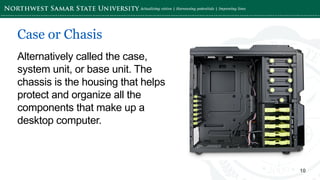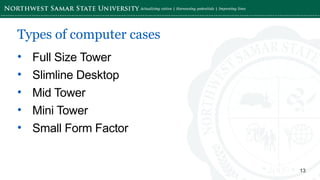Lesson-3-Introduction-to-Computer-PPT.pptx
- 3. ‘- 3 • Identify basic parts of a computer • Understand the function of each hardware component. • Appreciate the importance of computer on learning Objectives:
- 4. ‘- 4 • is a programmable device that stores, retrieves, and processes data. • The term "computer" was originally given to humans (human computers) who performed numerical calculations using mechanical calculators, such as the abacus and slide rule. Computer
- 6. ‘- 6 Ancient Computer Modern Computer
- 7. ‘- 7 The first digital computer and what most people think of as a computer was called the ENIAC (Electronic Numerical Integrator and Computer). It was built during World War II (1943-1946) and was designed to help automate the calculations being done by human computers. By doing these calculations on a computer, they could achieve results much faster and with fewer errors. History of Computer
- 8. ‘- 8 • To compute Business, Education, Healthcare, Retail and Trade, Government, Marketing, Science, Publishing, Arts and Entertainment, Communication, Banking and Finance, Transport, Navigation, Working From Home, Military, Social, Booking Vacations, Security and Surveillance, Weather Forecasting, Robotics Computer before: Computer Now
- 9. ‘- 9 As technology advances, older technologies, such as a floppy disk drive and Zip drive (shown below), are no longer required or included. What components make up a desktop computer?
- 10. ‘- 10 Alternatively called the case, system unit, or base unit. The chassis is the housing that helps protect and organize all the components that make up a desktop computer. Case or Chasis
- 11. ‘- 11 • Structure • Protection • Cooling • Noise • Aesthetics Why do we need a computer case?
- 12. ‘- 12 • Expansion Cards • Heat sink / Heat fans • Drives • RAM • Motherboard • PSU • CPU Components found inside a chassis
- 13. ‘- 13 • Full Size Tower • Slimline Desktop • Mid Tower • Mini Tower • Small Form Factor Types of computer cases
- 14. ‘- 14
- 15. ‘- 15 lternately called a processor, central processor, or microprocessor, the CPU (pronounced sea-pea-you) is the central processing unit of the computer. A computer's CPU handles all instructions it receives from hardware and software running on the computer. For example, the CPU processed the instructions to use a web browser to open and display this web page on your computer. CPU
- 16. ‘- 16 The processor is placed and secured into a compatible CPU socket found on the motherboard. Processors produce heat, so they are covered with a heat sink to keep them cool and running smoothly. To help transfer the heat between the CPU and the heat sink CPU
- 17. ‘- 17 The CPU's main function is to take input from a peripheral (keyboard, mouse, printer, etc) or computer program, and interpret what it needs. The CPU then either outputs information to your monitor or performs the peripheral's requested task. What does the CPU do?
- 18. ‘- 18 The CPU was first invented and developed at Intel with the help of Ted Hoff and others in the early 1970s. The first processor released by Intel was the 4004 processor CPU History
- 19. ‘- 19 Over the history of computer processors, the speed (clock speed) and capabilities of the processor have dramatically improved. For example, the first microprocessor was the Intel 4004 released on November 15, 1971, and had 2,300 transistors and performed 60,000 operations per second. The Intel Pentium processor has 3,300,000 transistors and performs around 188,000,000 instructions per second. CPU
- 20. ‘- 20 As with any device that utilizes electrical signals, the data travels near the speed of light, which is 299,792,458 m/s. How close to the speed of light a signal can get depends on the medium (metal in wire) through which it's traveling. Most electrical signals are traveling at about 75 to 90% the speed of light. How fast does a CPU transfer data?
- 21. ‘- 21 Alternatively called main memory, primary memory, or system memory, RAM (Random-Access Memory) is a hardware device that allows information to be stored and retrieved on a computer. However, unlike ROM (Read-Only Memory), RAM is a volatile memory and requires power to keep the data accessible. If the computer is turned off, all data contained in RAM is lost. RAM
- 22. ‘- 22 • DIMM (Dual Inline Memory Module) • SIMM (Single Inline Memory Module) • SO-DIMM (Small Outline Dual Inline Memory Module) Types of RAM
- 23. ‘- 23 Short for Read-Only Memory is a storage medium used with computers and other electronic devices. As the name indicates, data stored in ROM may only be read. It is either modified with extreme difficulty or not at all. ROM is mostly used for firmware updates. ROM is non-volatile, not requiring power to store data. ROM
- 24. ‘- 24 A ROM chip is a non-volatile storage medium, which means it does not require a constant source of power to retain the information stored on it. By contrast, a RAM chip is volatile, which means it loses any information it is holding when the power is turned off. Essentially, ROM is used for permanent storage, and RAM is for temporary storage. ROM
- 25. ‘- 25 WHAT IS THE RELATION BETWEEN INPUT DEVICES, OUTPUT DEVICES AND STORAGE DEVICES
- 26. ‘- 26 • Access to Information • Interactive Learning Tools • Collaboration and Communication • Skill Development • Efficiency in Learning • Multimedia Learning Why Computer is important in “Learning”?
Editor's Notes
- #17: Draw Something on the board
- #18: Draw Something on the board
- #19: Transistor is a device that controls electrical current by acting as an amplifier or a switch.
- #20: Transistor is a device that controls electrical current by acting as an amplifier or a switch.
- #25: Reporting about input output and storage devices

























